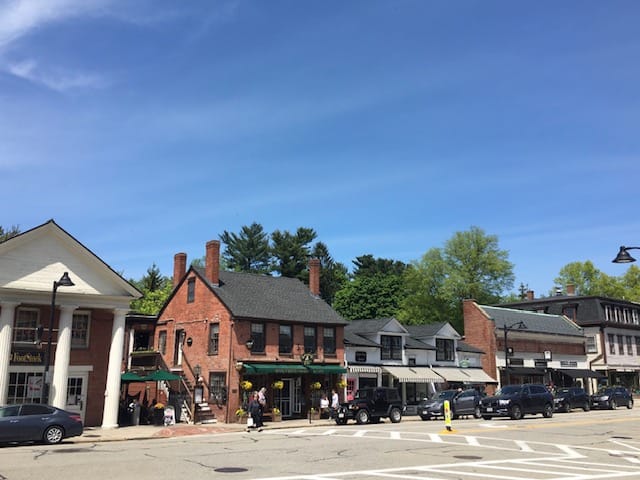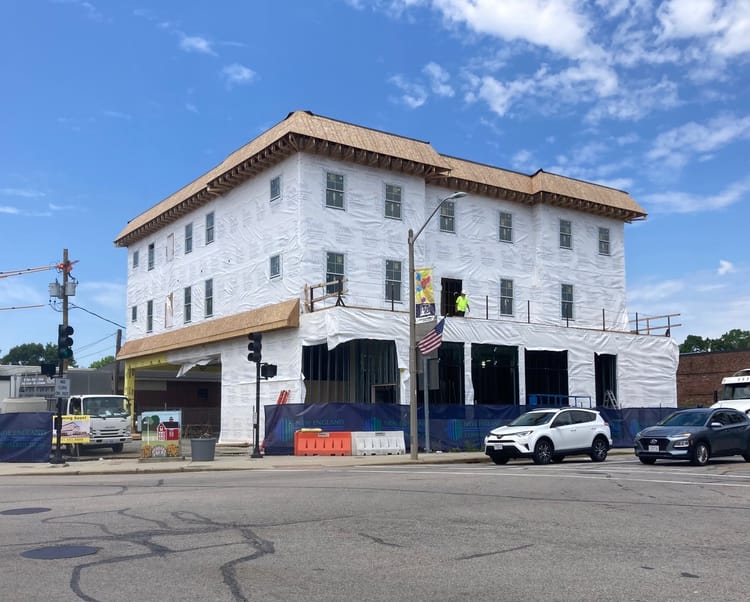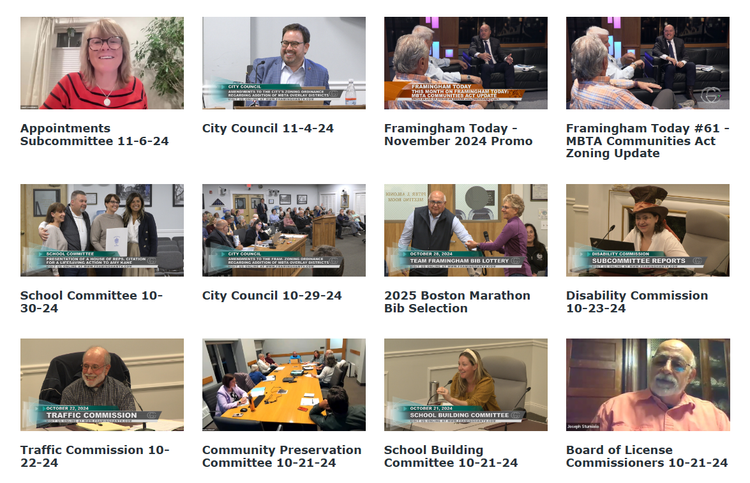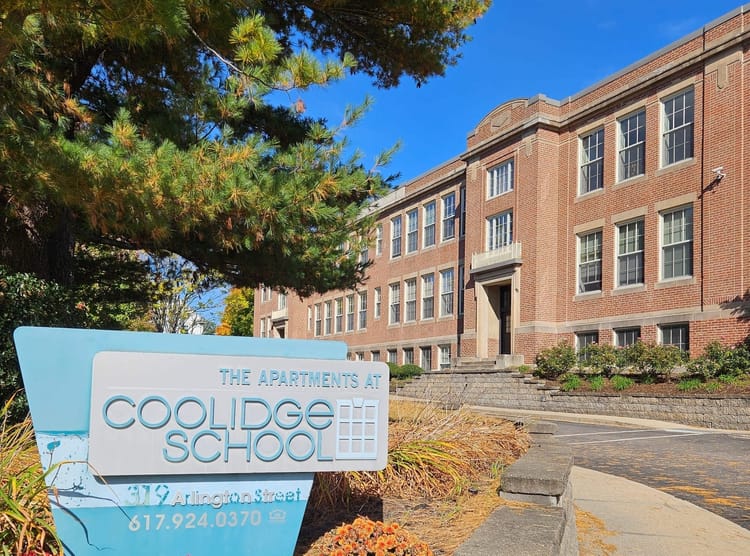Want to understand MBTA-C's potential impact? It's all in the details

Upzone Update offers analysis of MBTA-C compliance efforts, produced by zoning expert Amy Dain and the staff of Boston Indicators. This week's article is by Amy Dain.
It has been an intense spring of zoning reform, as housing prices continue to escalate. The Upzone Update has been reporting on wins, opportunities, and also some disappointments.
Stay tuned for more editions of the Upzone Update due out in the fall, when votes on zoning reform will resume, and the SJC will hear the Milton case.
In the meantime, don’t hesitate to be in touch with your own insights and updates. Contact us at upzoneupdate@bostonindicators.org.
MBTA Communities Has Encouraged Cities and Towns to Shrink Parking Minimums
Boston’s suburbs have saddled multifamily development with too much parking. The most common requirement in the zoning tables of parking ratios for multifamily housing has been two off-street parking spaces per dwelling unit. As a result, parking got overbuilt, project by project.
Fortunately, a movement emerged, in Massachusetts and nationwide, to reduce and even eliminate the parking ratios on walkable Main Streets and transit-accessible locations. MBTA Communities zoning has accelerated the shift in Massachusetts.
In adopting MBTA Communities zoning, Newton waived on-site parking requirements altogether for small-scale village-oriented multifamily projects, and reduced the mandate to either one spot or 0.5 spots per dwelling unit for larger projects. Chelsea requires one space per dwelling unit in MBTA Communities districts; Braintree requires 1.5 or 1.25 spaces, depending on the location. In Watertown Square, the proposal (not yet voted on) is to require a half-space per dwelling unit. Most MBTA Communities districts, so far, include requirements for fewer than two spaces per home—progress.
But not every district! For example, right by its train stations, in its walkable neighborhoods that boast every amenity, Concord is requiring two parking spaces per market-rate dwelling unit (and 1.5 spaces for subsidized housing and elderly housing).
Why would any community want to require so much parking? At least in part because most drivers are familiar with a certain existential panic: If you can’t park, you can’t go home, or arrive anywhere. And even if you know you’ll find a space eventually, circling means time lost irredeemably, schedules thrown off, important things missed. Plus, having open curb space in front of homes is both convenient for homeowners and enhances their sense of privacy within the neighborhood setting. The conventional assumption has been that ample on-site parking, on every property, would solve these issues.
But the problems of excess parking on multifamily properties are multiple and serious. Ample parking invites drivers and driving; it worsens traffic. On-site parking adds to the cost of development and price of housing, undermines pedestrian-friendly design, and is bad for the environment. Parking ratios limit the number of homes that can fit on a parcel of land. Parking lots are unpleasant; internal parking bulks up buildings; and underground garages are expensive. Parking requirements reduce options for carless households to find housing that doesn’t include parking.
On-site parking has a way of draining neighborhood life. Residents who come and go from on-site parking may never greet neighbors on the sidewalk, or get tempted into shops, from the sidewalk.
The MBTA Communities zoning law does not itself require any particular parking ratio. But, the worksheet that the state designed to calculate the “zoning capacity” of districts assesses the effects of parking requirements on potential buildout. If a community requires a lot of parking, it might need to draw a bigger district to reach its assigned zoning capacity target. This calculation, plus a growing understanding of parking’s ills, has encouraged communities to require less parking.
Also, many local policymakers have been learning that developers will build “enough” or “just right” on-site parking, without being required to, because homebuyers and renters want (and will pay for) convenient parking. A certain amount of on-site parking is market-driven. Developers can be more responsive to demand for parking than municipal regulators.
The next-level challenge for suburban planners is to design neighborhood-scale parking solutions such that builders will choose to limit or eliminate on-site parking, but without causing neighborhood parking headaches. The region’s most desirable walkable, transit-rich, amenity-rich neighborhoods were built before on-site parking dominated buildout of each property. The best way to enhance these places is to manage parking at the neighborhood level, so that property owners can continue building in the New England tradition.
Inclusionary Requirements Spark Controversy: Are They a Barrier to Building?
Does inclusionary zoning hamper housing production and drive up home prices? MBTA Communities is in the middle of this debate.
The state implementation guidelines for the MBTA Communities zoning law allow for inclusionary zoning requirements to cover their complying multifamily districts. Per the guidelines, municipalities can require that up to 10 percent of units be set aside as affordable to households earning up to 80 percent of area median income (AMI). If municipalities would like to require more than 10 percent affordability, or deeper affordability, they must provide an economic feasibility analysis, to show that the requirement will not stop housing production. Many have done that.
In an economic feasibility analysis conducted for Concord in February 2024, planning and real estate consulting firm RKG Associates concluded: “Based on the results for Concord across project scenarios, market rate asking rents are strong enough to support projects with a 20 percent set-aside at 80 percent of AMI that are built using wood-frame construction with surface parking, which meets the requirements for Concord’s districts.” Concord approved zoning with the 20 percent inclusionary requirement.
Alexis Smith, an MAPC analyst who has conducted multiple such market assessments, concluded in a guest article to the Upzone Update, “At a density of 15 units per acre by right, most municipalities can ask for more than 10 percent at 80 percent AMI and still maintain economic feasibility.” Her conclusion is based on data recorded in recent years when many mixed-income projects were successfully built, under varied inclusionary zoning policies.
But economic feasibility is an ever-moving target. Jeff Rhuda of Symes Associates disagrees with Smith’s take. He argues, “There was a time when building an affordable unit was close to a break-even equation—building cost vs selling price. Today every affordable unit is at least a $100–250,000 loss. The greater the inclusionary percentage the more likely the deal does not work.”
Scott Van Voorhis in the blog Contrarian Boston argues that local inclusionary zoning requirements pose a serious challenge to housing production, undermining the landmark zoning law. He suggests that the market assessments by third party experts aren’t taking into account current market headwinds. Van Voorhis quotes Rhuda: “If adding one or two affordable units takes away tens of market-rate units, then they are defeating the whole purpose of the MBTA zoning.” It is a serious concern.
State Policy Updates
Plans in the Works
Many people are asking what the Healey Administration has planned next, especially since MBTA Communities is only a piece of the housing policy puzzle. So, eyes are on the Administration’s two advisory groups that have been delving into the details and big picture of reform.
The state’s Housing Advisory Council has been working to create a state housing plan, due out this coming winter. The Council and the Executive Office of Housing and Livable Communities (EOHLC) held 14 public listening sessions to gather input for the plan. Simultaneously, the state’s Commission on Unlocking Housing Production has been deliberating about possible recommendations for policies to reduce barriers to housing development.
Accessory Dwelling Units
The House of Representatives passed ADU legislation, making minimal changes to the language proposed by Governor Maura Healey. Here is a link to the language that the House approved. The ADU legislation was embedded in the $6.5 billion housing bond bill.
The next step is for the Senate to take up the bill. Once Senate Ways & Means introduces it, Senators may propose amendments, which would be debated by the full Senate. After Senate approval, a conference committee would establish a compromise bill. The conference committee could take until the end of the legislative session on July 31.
The ADU language approved by the house would prohibit municipalities from prohibiting ADUs in single-family residential zoning districts:
“No zoning ordinance or by-law shall prohibit, unreasonably restrict or require a special permit or other discretionary zoning approval for the use of land or structures for a single accessory dwelling unit, or the rental thereof, in a single-family residential zoning district; provided, that the use of land or structures for such accessory dwelling unit under this paragraph may be subject to reasonable regulations, including, but not limited to, 310 CMR 15.000 et seq., if applicable, site plan review, regulations concerning dimensional setbacks and the bulk and height of structures and may be subject to restrictions and prohibitions on short-term rental, as defined in section 1 of chapter 64G.”
The language also specifies that municipalities shall not require owner occupancy of the house or ADU. Also municipalities shall not require more than one parking space for the ADU, and shall not require any parking for ADUs located within a half-mile of public transit stations.
Note that the ADU legislation amends Chapter 40A, which does not apply to the City of Boston. Mayor Wu’s administration is looking to legalize ADUs by-right citywide, but with an owner-occupancy requirement.
Chapter 40B
Jennifer Gilbert of Housing Navigator Massachusetts and Aja Kennedy of Boston Indicators shared an analysis of Chapter 40B that shows the way to potential pro-housing reform. Chapter 40B lets certain mixed-income housing developments bypass local zoning, when less than 10 percent of a municipality’s homes are counted on the state’s Subsidized Housing Inventory. The thing is, the Inventory counts all rental units permitted via 40B, whether or not those units are restricted-affordable. Many expensive market-rate units are bringing municipalities over their “10 percent,” and letting the communities reject new 40B developments.
Gilbert and Kennedy explain: “Using the official yardstick, 69 municipalities in the state have achieved the 10 percent threshold. However, when we apply our criteria to count only truly affordable units, nearly two-thirds of those communities fall below the threshold.” If the state were to only count affordable units in the inventory, more municipalities would have to permit qualifying projects under Chapter 40B, which has been a major engine of housing permitting since its adoption in 1969.
Spotlight on Walpole, a TOD Success Story
Walpole offers a success story of transit-oriented development (TOD) providing not only much needed housing in a walkable, transit-connected neighborhood, but also revitalizing the central business district. Before Walpole permitted hundreds of TOD apartments in recent years, Walpole’s 2015 Downtown Action Plan concluded: “There is not a concentration of high density housing … which is needed to support a more robust retail environment.” Now, after new apartment buildings have risen, the retail environment has improved, and restaurants are thriving, with patio seating throughout downtown.
The zoning for this as-of-right TOD mixed-use development had actually been on the books for decades, adopted with the intention of revitalizing Main Street. A few medium-sized mixed-use projects had gone up near Main Street in decades past, but it took a while for the market to catch up with what the zoning allowed. In the last few years, Walpole saw a few hundred new apartments go in, and several more projects are now under construction or in permitting.
Given the robust as-of-right zoning that Walpole already had, Walpole only needed to make a few small tweaks to it, to comply with MBTA Communities. The Town did extend the MBTA Communities zoning for “gentle density” buildout just beyond the central business district, creating new “zoning capacity” for housing development, beyond what had been allowed before.
More News
The Eagle Tribune shared a pro-housing editorial about MBTA Communities: “Going forward, cities and towns—and the state—still have a lot of work to do to implement the law so that it brings more affordable housing to cities and towns where costs are out of reach for most people. These new units can’t come soon enough.”
Gary Kerr of Greystar writes in CommonWealth Beacon: “Zoning needs to reflect the current situation by creating real opportunities to build housing at scale, rather than adding a few additional units here and there.”
In Banker & Tradesman, Scott Van Voorhis suggests the far-right and far-left are coming together to undermine zoning reform.
Mike Scott, Co-Managing Partner of Nutter, offers in Boston Business Journal an in-depth analysis of barriers to affordable home building, including “high land costs, rising construction costs, sustainability requirements (much needed, but costly), interest rates and expansive community-benefits packages necessary to earn public support.” Time-intensive, unpredictable permitting also adds to costs. He points to a project in Somerville to illustrate potential solutions:
A recently approved Somerville project is a case study in creative thinking. A new 288-unit housing project on a long unoccupied Winter Hill site is moving forward with 50 percent affordable units. The key to moving forward? The city changed parking requirements, approved tax incremental financing, and provided additional financial support via the Somerville Affordable Housing Trust.
WBUR’s Radio Boston devoted a whole show to discussing MBTA Communities zoning, with an in-depth look at Brookline, Newton, and Ipswich.
The Lexington Observer reports that three developments proposed for MBTA Community zones in Lexington are awaiting approval through the Planning Board’s site plan review process. The article focuses on one of the projects, at Lois Lane.
MetroWest Daily News focuses in on what Lieutenant Governor Kim Driscoll and Secretary Ed Augustus have to say about Massachusetts’ housing challenges.
Upcoming Event:
How to Build an ADU in Needham
Hosted by the Needham Housing Coalition
Wednesday, June 26
7:00 pm – 8:30 pm
Center at the Heights, and Zoom





